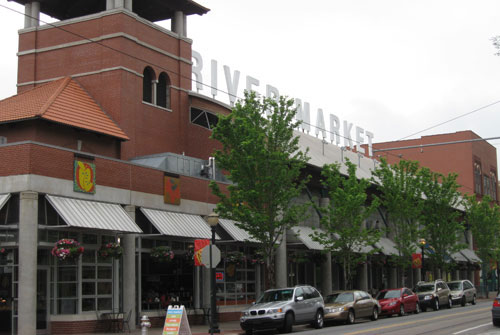President Clinton Avenue: Little Rock, Arkansas

Summary
The transformation of Little Rock's East Markham Street to what is now President Clinton Avenue was, in the words of a long-time Little Rock business leader, "an overnight success 20 years in the making." The avenue is a popular destination and hub of activity with a mixture of restaurants, museums, art galleries, entertainment venues, stores, offices, educational facilities, apartments, and loft condominiums. Some 30 sidewalk benches, almost 150 street trees, decorative lighting, designed walkways, outdoor sculptures, and scenic views make for a memorable experience.
Designated Area
The entire length of President Clinton Avenue is designated an American Planning Association Great Street, between the Clinton Presidential Center and Park to the east and Cumberland Street to the west.

Built in 1996, the River Market was part of a long-range plan to redevelop Markham Street, later renamed President Clinton Avenue. Photo courtesy of Eve Jorgensen.
Planning Excellence
In 1982, the city published its downtown development plan, suggesting that the street and its boarded up warehouses become an entertainment district. A waterfront park along the Arkansas River was built in 1986.
Planning for the district continued with $300 million in riverfront development, including the 10,000-square-foot River Market that opened at the corner of East Markham and South Commerce streets in July 1996. One year later the decision to locate the William J. Clinton Presidential Center at the street's eastern terminus was announced. The street was renamed President Clinton Avenue in 2001, and the library opened in November 2004.

The River Rail trolley connects President Clinton Avenue with the rest of downtown and North Little Rock across the Arkansas River. Photo courtesy of Eve Jorgensen.
Defining Characteristics, Features
Lively Pedestrian Experience
- Buildings have zero setbacks so storefronts contribute to the avenue's lively and rhythmic pedestrian experience
- A plethora of activities is concentrated along the avenue: shopping, dining, tours, exhibits, educational programs, entertainment, and special events
- $20 million River Rail electric trolley line expanded service to President Clinton Avenue in 2005; trolley carried 200,000 passengers during its first year (2004-05)
- 15,000-square foot farmer's market occurs Tuesday and Saturday mornings at River Market, which overlooks Riverfront Park
- The avenue and adjoining Riverfront Park are the primary venue for annual Riverfest; the family-oriented festival is the single-largest event in Arkansas (more than 250,000 attendees in 2008); goes back to 1977
Sustained Planning Effort
- Implementation of 1982 plan recommendations for East Markham Street entertainment district include building amphitheater at the 33-acre Julius Breckling Riverfront Park in 1987; park immediately adjoins President Clinton Avenue
- Community-wide Future Little Rock planning process in 1991 builds upon 1982 plan for an East Markham Street entertainment district; additional recommendations include electric trolley and walking trail to connect area with central business district
- East Markham Streetscape Master Plan implemented in 1995, including brick sidewalks and new street trees
- Voters approve $1.5 million bond issue in 1994 for improvements to Riverfront Park including new walkways connecting to President Clinton Avenue and Main Street
- City Board of Directors approve a Design Overlay District for the River Market area in 1996; creates a framework and rules for area's future growth and development
- Other development along street during 1990s includes relocation of Museum of Science History to the Terminal Building and the Central Arkansas Main Library moves near East Markham and Cumberland streets
Successful Revitalization
- $165 million William J. Clinton Presidential Center and Park; includes presidential library, archives building, renovated train depot that serves as a school, and nearly 30 acres of parkland; library building is certified LEED Platinum with solar panels, green roof, bike racks and floors made from recycled rubber tires
- Since streets was renamed (2001), city has attracted $1.5 billion in economic development; $1 million in sidewalk and streetscape improvements also made
- The Design Overlay District, approved in 1996 and updated in 2003, regulates buildings, signs, street furnishings and landscaping to ensure new development complements existing buildings while maintaining a festive and pedestrian orientation
- River Market District Review Committee requires public hearing for proposed variances to street front buildings; allows citizen input on new development
- The nonprofit Downtown Partnership is advocate for additional downtown growth, especially along riverfront and President Clinton Avenue
- First Security Building (521 President Clinton Avenue) is first new building downtown to contain mixed uses; includes bank, hotel, offices and condominiums
Contextual Design and Adaptive Reuse
- Clinton library designed by New York City architect James Polshek, who worked for the renown modernist architect I.M. Pei; inspired by President Clinton's vision of the library being a "bridge to the future," library building reflects contextual approach, echoing elements of the Interstate 30 overpass that adjoins Clinton grounds
- Several warehouses renovated for new uses, including two abandoned warehouses at 405 President Clinton Avenue now used by Arkansas Studies Institute
- Terminal Warehouse Building adaptation for Museum Center completed in 1998
- East Markham Street National Register Historic District for Market Row buildings is comprised of four buildings designed by prolific architect Charles L. Thompson during late 19th and early 20th centuries

President Clinton and daughter, Chelsea, outside the Little Rock River Market during his last trip back to Arkansas as president. Photo courtesy of William J. Clinton Presidential Library.


